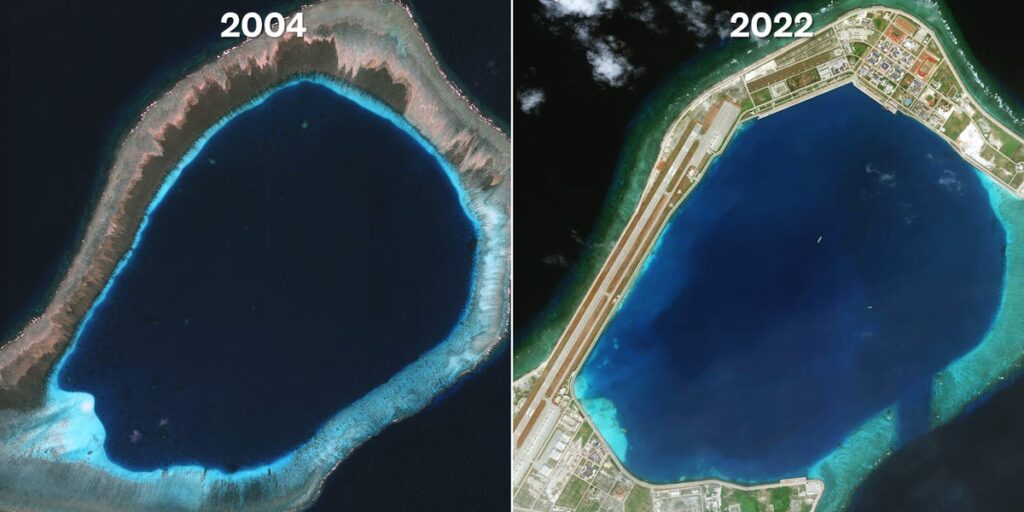X
Copy link
Impact Link
Save
Saved
Read in app
subscribers. Become an Insider
and start reading now.
Have an account? .
- Tensions continue in the South China Sea, most recently between China and the Philippines.
- China has been extending its reach in the South China Sea by building artificial islands atop reefs.
- China’s claims over these islands is unlawful and many countries are fighting back.
Tensions between China and the Philippines are heating up over tiny sandbars and coral reefs in the South China Sea, and the US could get caught in the middle.
“We should be worried about it,” Greg Poling, director of the Southeast Asia Program and Asia Maritime Transparency Initiative, told Business Insider.
The satellite images below show China’s massive expansion across the South China Sea, which has turned open waters into a looming battleground that could rope the US in.
Over the last decade, China has expanded hundreds of miles south by building artificial islands over underwater reefs in the Paracel and Spratly Islands in the South China Sea.
This has been a yearslong power struggle between China and many countries, including the Philippines, Vietnam, and Taiwan, for control of dozens of disputed reefs, islands, and sandbars in the South China Sea.
Up to $5 trillion in goods are shipped across the sea a year.
The problem is that China’s claims of sovereignty over these artificial landmarks are unlawful, according to the United Nations Convention on the Law of the Sea (UNCLOS).
Mischief Reef is one of China’s largest artificial islands in the Spratlys, spanning 1,380 acres, enough to fit 1.5 Central Parks.
Both the Philippines and China, as well as Taiwan and Vietnam, claim the reef as their own. However, a UN tribunal ruled in 2016 that no territory can claim it.
That didn’t stop China from building an impressive military base there.
Satellite images show that China has militarized Mischief Reef with missile systems, fighter jets, naval ships, and more.
In recent months, multiple Chinese vessels in the South China Sea have threatened to collide with Philippine ships in a region called Scarborough Shoal, north of Mischief Reef.
Also in Scarborough Shoal, a Chinese Navy helicopter flew dangerously close, within 10 feet, of a Philippine patrol plane in February, AP reported.
Meanwhile, another recent conflict has flared over a disputed series of sandbar islands in the Spratlys called Sandy Cay.
Sandy Cay isn’t an underwater reef. The islands remain above ground at high tide, which grants them legal status as a “rock” (or land surrounded by water) under UNCLOS.
This means that whoever is the rightful sovereign can also claim 12 nautical miles of the waters around it, Poling said.
Last week, Chinese state media released a photo of the Chinese coast guard holding the Chinese flag on Sandy Cay, claiming ownership.
Both China and the Philippines claim sovereignty over Sandy Cay, but neither has it legally.
Several days later, the Philippine coast guard responded, releasing a photo of its national guard holding a Philippine flag on Sandy Cay.
The photo-off on Sandy Cay is more of a stunt than a threat, Poling said.
However, if matters escalate in the South China Sea, particularly in Scarborough Shoal, the US has a mutual defense treaty with the Philippines, agreeing to come to its aid in the event of an armed attack. It hasn’t reached that point and will likely deescalate before that, Poling said.
Subi Reef is another one of China’s artificial islands outfitted with a military base.
“It is illegally occupied unless China can claim the territorial sea in which it sits,” Poling said.
About 100 miles southwest of Subi Reef is Fiery Cross Reef.
While China, Vietnam, and the Philippines all lay claim to the reef, China’s military presence gives it effective control.
However, China is no longer the only nation building artificial islands in the South China Sea.
Vietnam has greatly developed part of the Barque Canada reef over the last several years.
Vietnam is also developing on Discovery Great Reef, another underwater region in the Spratly Islands.
At 118 acres, though, it’s nowhere near the scale of some of China’s developments on Mischief, Subi, and Fiery Cross Reefs.
“The Philippines, Vietnam, even Malaysia and Indonesia have done a pretty good job holding firm,” Poling said, adding that, “I think China just believes it can outlast the other claimants, and that if it keeps up this persistent cycle of pressure, eventually they’ll all crack.”
Learn more about what’s been happening in the South China Sea in the video below:
Read the full article here


